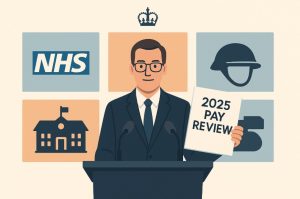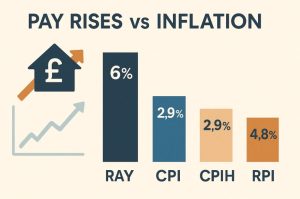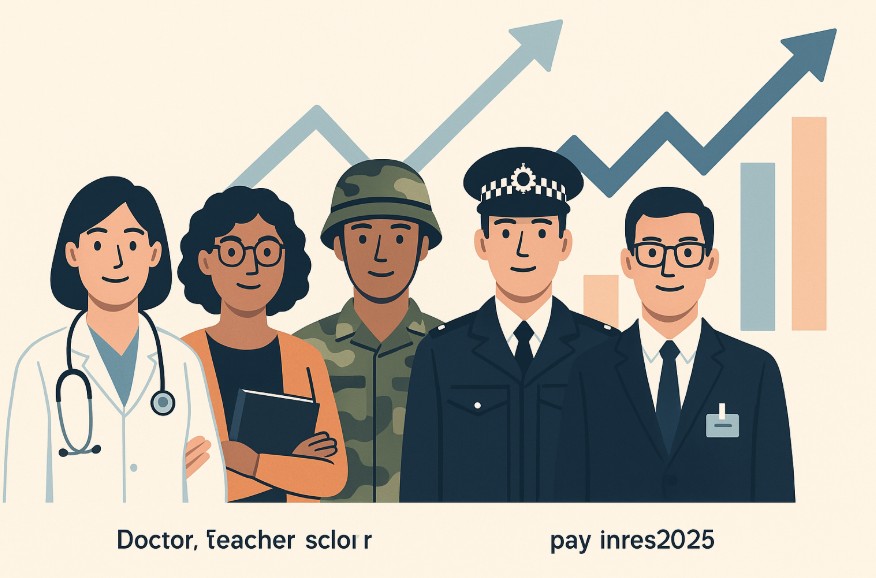The UK Government has confirmed new public sector pay rises for 2025, following recommendations from independent pay review bodies.
With increases ranging from 3.6% to 4.5%, and some groups receiving additional payments, these decisions aim to support recruitment, retention, and morale across essential services.
While most proposals were accepted, some adjustments have sparked debate over fairness and funding.
This article explores who will benefit, how much they’ll receive, and what the changes mean in real terms.
What Has the Government Announced About Public Sector Pay Rises in 2025?

In 2025, the UK Government confirmed the implementation of new public sector pay rises based on the recommendations from six of the eight Pay Review Bodies.
These review bodies are independent panels tasked with assessing appropriate pay increases for different groups of public sector employees.
The increases are seen as a response to continued cost-of-living pressures, inflationary concerns, and growing retention issues across public services.
The uplifts range from 3.6% for NHS workers to a proposed 4.75% for the judiciary, although the latter was adjusted down to 4% by the Government.
Importantly, these increases generally surpass the Consumer Prices Index (CPI), which stood at 3.5% in April 2025. However, they do not outpace other key inflation indicators like the CPIH at 4.1% or the Retail Price Index (RPI) at 4.5%.
The Government has stated that this pay review round prioritises fairness, affordability and economic stability. By mostly accepting the PRB recommendations, it has shown support for core public workers while also preserving its budget strategy.
Who Are the Main Beneficiaries of the 2025 Pay Uplift?
The 2025 public sector pay uplift directly benefits a wide range of public sector workers across England and Wales. These increases aim to acknowledge the ongoing contributions of key workers and to address pressing recruitment and retention challenges in critical services.
The pay review bodies involved in the process have made targeted recommendations based on workload demands, inflation, and the competitive landscape in both public and private sectors.
Armed Forces (AFPRB)
Personnel in the armed forces will receive a 4.5% increase in basic pay from April 2025. This uplift is designed to retain experienced officers and support recruitment amid increasing operational demands.
Given the physical and emotional demands of military roles, the AFPRB’s recommendation was welcomed and accepted in full by the Government.
Doctors and Dentists (DDRB)
Doctors and dentists, including those in training, will benefit from a 4% rise in basic pay along with a consolidated payment of £750 for trainees.
This move addresses concerns about burnout, especially among junior doctors, and forms part of a broader NHS workforce plan aimed at stabilising staff numbers. The increase applies across England and Wales and is scheduled for April 2025 implementation.
NHS Staff (NHSPRB)
NHS staff not covered under the DDRB, such as nurses, paramedics, and administrative support, will receive a 3.6% uplift in basic pay. While this is one of the lower percentage increases across the public sector, it still exceeds the CPI inflation rate and reflects a recognition of the continuing pressures faced by NHS staff in delivering frontline care.
Prison Officers and Staff (PSPRB)
Those working in England and Wales under the Prison Service Pay Review Body will see a 4% rise in basic pay. In addition, operational support staff are set to receive a temporary 5% increase in unsocial hours payments, effective for two years starting from April 2025.
This reflects the growing difficulty in retaining staff in high-stress prison environments and aims to improve overall staffing resilience.
School Teachers in England (STRB)
School teachers are set to receive a 4% increase in all salary ranges and advisory points, effective from September 2025. However, only 3% of this award is funded through new government investment, with the remaining 1% expected to be absorbed by schools through internal efficiencies.
While this uplift supports teacher pay competitiveness, unions have raised concerns about the implications for school budgets and staffing levels.
Senior Civil Servants and Executives (SSRB)
The Senior Salaries Review Body has recommended differentiated increases for senior roles:
- 25% for senior civil servants and senior NHS managers
- 75% for senior military officers
- 4% for members of the judiciary (reduced from the 4.75% recommended)
These uplifts are aimed at maintaining leadership standards in complex government operations. The Government has partially accepted the SSRB’s recommendations, reflecting the need for prudent fiscal management alongside rewarding performance in senior positions.
How Much More Will Each Public Sector Group Receive?

The following table outlines the approved pay increases for different groups and when they come into effect:
| Public Sector Group | Pay Review Body (PRB) | Basic Pay Uplift | Effective Date |
| Armed Forces | AFPRB | 4.5% | April 2025 |
| Doctors & Dentists | DDRB | 4% + £750 (trainees) | April 2025 |
| NHS Staff (England & Wales) | NHSPRB | 3.6% | April 2025 |
| Prison Service Staff | PSPRB | 4% + 5% unsocial hours (temporary) | April 2025 |
| School Teachers (England) | STRB | 4% (only 3% is new funding) | September 2025 |
| Senior Civil Servants & NHS Executives | SSRB | 3.25% | April 2025 |
| Senior Military Officers | SSRB | 3.75% | April 2025 |
| Judiciary | SSRB | 4% (revised from 4.75%) | April 2025 |
A further breakdown reveals that operational support staff in prisons are set to receive an additional 5% temporary increase in their unsocial hours pay for a period of two years beginning April 2025. The inclusion of this temporary benefit illustrates targeted support for roles experiencing operational challenges.
Why Were Some Pay Recommendations Only Partially Accepted?
While the majority of PRB proposals were implemented in full, two groups had their recommendations adjusted.
The judiciary, originally set to receive a 4.75% increase based on the SSRB’s recommendation, were instead granted a 4% uplift.
The Government’s rationale was based on affordability, stating that while it recognises the importance of judicial roles, the economic climate required a moderated approach.
The second deviation occurred in the education sector. Teachers were recommended a 4% uplift, which the Government agreed to implement.
However, it introduced a caveat: schools must fund the first 1% through internal budget adjustments and productivity gains. This effectively means only 3% of the increase is supported by new public funding.
This approach is part of a broader strategy to encourage fiscal responsibility within departments while still enabling pay improvements. The Secretary of State for Education stressed that schools should improve operational efficiency to deliver the full pay award without undermining service delivery.
What About Sectors Still Waiting for a Decision?
As of mid-2025, two significant groups are still awaiting confirmation of their pay outcomes. These include police officers and staff within the National Crime Agency.
Their recommendations are being reviewed under the PRRB and NCARRB, respectively, and have not yet been submitted to the Government.
Pending groups include:
- Police officers across England and Wales
- Chief police officers under SSRB jurisdiction
- Employees of the National Crime Agency (NCA)
These sectors have historically faced delays in receiving decisions, often due to more complex negotiations involving law enforcement funding, performance metrics, and inter-agency coordination.
However, expectations remain high for increases aligned with those already announced for other uniformed and front-line services.
How Do These Pay Rises Compare with Inflation and Cost of Living?

With the UK still navigating high inflation levels, comparisons between pay increases and the cost of living are crucial to assessing the real-terms benefit of these decisions.
While all PRB-approved pay rises exceed the CPI at 3.5%, they do not universally exceed broader measures such as CPIH and RPI.
The table below provides a comparative analysis of pay increases and key inflation benchmarks:
| Metric | Percentage |
| Average Public Sector Pay Rise | 3.6% – 4.5% |
| Consumer Price Index (CPI) | 3.5% |
| Consumer Prices Index including Housing (CPIH) | 4.1% |
| Retail Price Index (RPI) | 4.5% |
| Whole Economy Median (IDR) | 3.2% |
In practical terms:
- Pay rises are keeping pace with CPI, offering mild protection against base inflation
- They are falling short of CPIH and RPI, suggesting households may still feel pressure on housing and broader costs
- They perform above the whole economy median, reflecting a commitment to stabilise public sector competitiveness
This mixed outcome illustrates that while progress has been made, the broader issue of affordability continues to affect households, particularly those in lower-paying roles.
What Reactions Have Unions and Stakeholders Shared?
Trade unions and professional bodies have responded with cautious approval, acknowledging the above-inflation increases but also raising concerns about funding sustainability and real-terms purchasing power.
Key points raised by stakeholders include:
- Teaching unions expressed concern that expecting schools to self-fund 1% of the award might lead to reductions in staff development or learning resources
- NHS unions welcomed the additional £750 for trainees but reiterated calls for long-term retention strategies
- Prison service unions were generally supportive of the temporary unsocial hours payment but questioned what provisions would be made after the two-year period ends
Stakeholders also highlighted the importance of consistency in future pay settlements to avoid year-on-year uncertainty.
Many pointed out that although these increases are positive in the short term, public sector workers have experienced over a decade of below-inflation rises, and more sustained efforts are needed to close historical wage gaps.
What Does the 2025 Pay Rise Mean for the Future of Public Sector Work?

The 2025 pay awards represent a move toward restoring confidence in public sector employment after several challenging years marked by high attrition rates, increasing workloads and strike action in key services.
Long-term implications of these changes include:
- Improved morale across critical services like healthcare, education, and defence
- A modest reduction in the recruitment and retention gap, especially in specialist roles such as nursing and teaching
- Potential for future pay settlements to be linked more transparently to inflation, performance, and workload metrics
However, challenges remain in the form of funding pressures, regional pay inequalities and job satisfaction levels.
If public sector wages continue to lag behind the private sector in high-demand regions, issues of staffing shortages and workforce instability may persist.
To ensure the long-term viability of public services, these pay awards may need to form part of a broader strategy involving workforce planning, training investment and performance-based progression systems.
Conclusion
The 2025 public sector pay rise is largely a positive development, reflecting Government responsiveness to expert recommendations and worker needs.
While not without its compromises—particularly in the education and judicial sectors—it demonstrates a meaningful effort to align wages with inflation and economic conditions.
Nevertheless, the broader conversation around real-terms compensation, workforce morale, and long-term funding will remain pivotal.
Public sector workers are likely to welcome the uplift, but expectations for future settlements will now be higher.
FAQs About the 2025 Public Sector Pay Rise
What is the average pay rise across public sector groups in 2025?
The average uplift ranges between 3.6% and 4.5%, with slight variations depending on the department and role.
Why did the judiciary not receive the full recommended increase?
The Government adjusted the SSRB’s 4.75% recommendation to 4% to manage spending, while still acknowledging judicial workload demands.
Are the 2025 pay increases funded by new Government money?
Not entirely. For example, only 3% of the 4% teacher’s pay increase is funded by new government money; the rest must come from school budgets.
When will police officers know their 2025 pay award?
As of July 2025, the PRRB recommendations for police officers are still pending and expected later in the year.
How does the NHS pay rise compare to inflation?
At 3.6%, the NHS pay rise is above the CPI (3.5%) but below CPIH and RPI, making it only a modest real-terms increase.
Will there be additional benefits alongside the basic pay rise?
Yes, for example, operational prison staff will receive a temporary 5% uplift in unsocial hours pay from April 2025 for two years.
How do these pay rises impact public sector recruitment?
The pay increases aim to support recruitment and retention by making public sector roles more financially competitive.
Related Articles:








